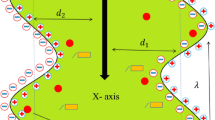Abstract
This study is concerned with reconciling theoretical modelling of the fluid flow in the airway surface liquid with experimental visualisation of tracer transport in human airway epithelial cultures. The airways are covered by a dense mat of cilia of length ∼ 6 μm beating in a watery periciliary liquid (PCL). Above this there is a layer of viscoelastic mucus which traps inhaled pathogens. Cilia propel mucus along the airway towards the trachea and mouth. Theoretical analyses of the beat cycle smithd, fulb predict small transport of PCL compared with mucus, based on the assumption that the epithelium is impermeable to fluid. However, an experimental study coord indicates nearly equal transport of PCL and mucus. Building on existing understanding of steady advection-diffusion in the ASL (Blake and Gaffney, 2001; Mitran,2004) numerical simulation of an advection-diffusion model of tracer transport is used to test several proposed flow profiles and to test the importance of oscillatory shearing caused by the beating cilia. A mechanically derived oscillatory flow with very low mean transport of PCL results in relatively little ‘smearing’ of the tracer pulses. Other effects such as mixing between the PCL and mucus, and significant transport in the upper part of the PCL above the cilia tips are tested and result in still closer transport, with separation between the tracer pulses in the two layers being less than 9%. Furthermore, experimental results may be replicated to a very high degree of accuracy if mean transport of PCL is only 50% of mucus transport, significantly less than the mean PCL transport first inferred on the basis of experimental results.
Similar content being viewed by others
References
Barlow, E., 2000. Modelling Muco-Ciliary Transport in the Lung. Master’s Thesis, School of Mathematics and Statistics, University of Birmingham, Birmingham, UK.
Blake, J.R., Gaffney, E.A., 2001. Modeling aspects of tracer transport in mucociliary flows. In: Salathe, M. (Ed.), Cilia and Mucus: From Development to Respiratory Defense. Marcel Dekker, New York, pp. 291–302.
Boucher, R.C., 1994, Human airway ion transport. Part 1. Am. J. Respir. Crit. Care Med. 150, 271–281.
Douglas, J., Jr., Peaceman, D., 1955. Numerical solution of two-dimensional heat flow problems. A. I. Chem. E. J. 1, 505–512.
Fauci, L., Dillon, R., 2006. Biofluidmechanics of reproduction. Ann. Rev. Fluid Mech. 38(1), 371–394.
Fulford, G.R., Blake, J.R., 1986. Muco-ciliary transport in the lung. J. Theor. Biol. 121, 381–402.
Leonard, B.P., 1979. A stable and accurate convective modelling procedure based on quadratic upstream interpolation. Comput. Methods Appl. Mech. Eng. 19, 459–98.
Lutz, R.J., Litt, M., Charkrin, L.W., 1973. Physical-chemical factors in mucus rheology. In: Gabelnick, H.L., Litt, M. (Eds.), Rheology of Biological Systems. Charles C. Thomas, Springfield, IL, pp. 119–157.
Matsui, H., Randell, S.H., Peretti, S.W., Davis, C.W., Boucher, R.C., 1998. Coordinated clearance of periciliary liquid and mucus from airway surfaces. J. Clin. Invest. 102(6), 1125–1131.
Mitran, S., 2004. Computation of advection and diffusion of a passive tracer in a prescribed velocity field. Available: http://www.amath.unc.edu/Faculty/mitran/research/PCL.html.
Okada, Y., Takeda, S., Tanaka, Y., Izpisúa Belmonte, J.-C., Hirokawa, N., 2005. Mechanism of nodal flow: A conserved symmetry breaking event in left-right axis determination. Cell 121, 633–644.
Quinton, P.M., 1994. Viscosity versus composition in airway pathology (editorial). Am. J. Respir. Crit. Care Med. 149, 6–7.
Sanderson, M.J., Sleigh, M.A., 1981. Ciliary activity of cultured rabbit tracheal epithelium: Beat pattern and metachrony. J. Cell Sci. 47, 331–341.
Sleigh, M.A., Blake, J.R., Liron, N., 1988. The propulsion of mucus by cilia. Am. Rev. Respir. Dis. 137, 726–741.
Smith, D.J., Gaffney, E.A., Blake, J.R., 2006a. Discrete cilia modelling with singularity distributions: Application to the embryonic node and the airway surface liquid. To appear in Bull. Math. Biol.
Smith, D.J., Gaffney, E.A., Blake, J.R., 2006b. A viscoelastic traction layer model of muco-ciliary transport. Published online first in Bull. Math. Biol. with doi: 10.1007/s11538-005-9036-x
Smith, J.J., Travis, S.M., Greenberg, E.P., Welsh, M.J., 1996. Cystic fibrosis airway epithelia fail to kill bacteria because of abnormal airway surface liquid. Cell 85, 229–236.
Taylor, G.I., 1951. Analysis of the swimming of microscopic organisms. Proc. R. Soc. Lond. A209, 447–461.
Taylor, G.I., 1953. Dispersion of soluble matter in solvent flowing slowly throught a tube. Proc. R. Soc. Lond. A219, 186–203.
Toskala, E., 1994. Normal and Pathological Respiratory Cilia. An Experimental and Clinical Study With Special Reference to Scanning Electron Microscopy. PhD Thesis, University of Kuopio, Finland.
Author information
Authors and Affiliations
Corresponding author
Rights and permissions
About this article
Cite this article
Smith, D.J., Gaffney, E.A. & Blake, J.R. A Model of Tracer Transport in Airway Surface Liquid. Bull. Math. Biol. 69, 817–836 (2007). https://doi.org/10.1007/s11538-006-9163-z
Received:
Accepted:
Published:
Issue Date:
DOI: https://doi.org/10.1007/s11538-006-9163-z




